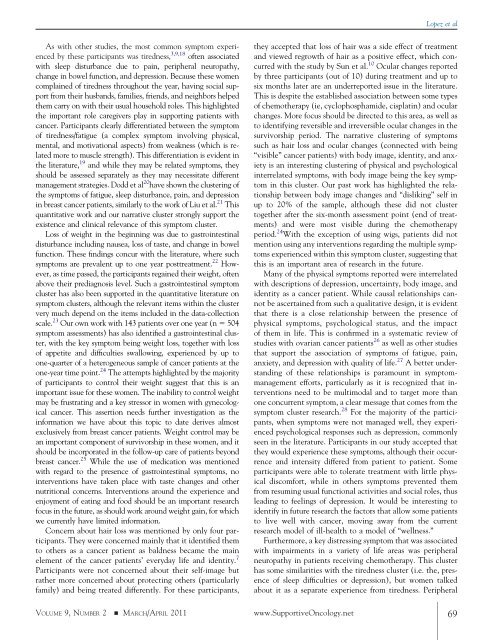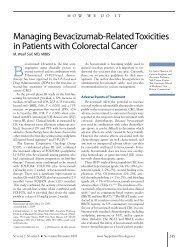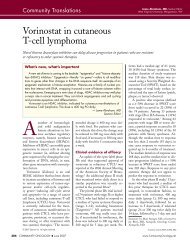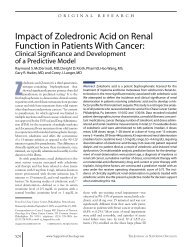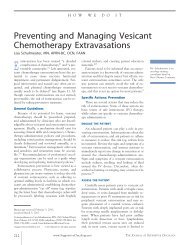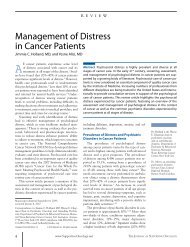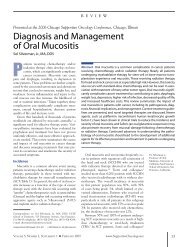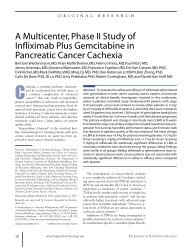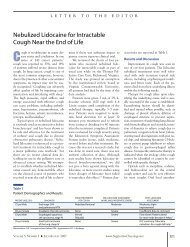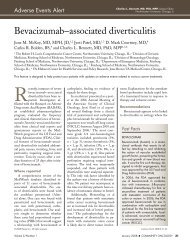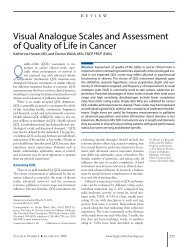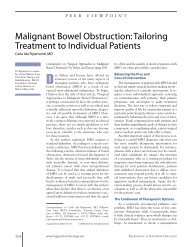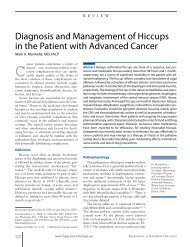Evaluating the “Good Death” Concept from Iranian Bereaved Family
Evaluating the “Good Death” Concept from Iranian Bereaved Family
Evaluating the “Good Death” Concept from Iranian Bereaved Family
You also want an ePaper? Increase the reach of your titles
YUMPU automatically turns print PDFs into web optimized ePapers that Google loves.
As with o<strong>the</strong>r studies, <strong>the</strong> most common symptom experienced<br />
by <strong>the</strong>se participants was tiredness, 3,9,18 often associated<br />
with sleep disturbance due to pain, peripheral neuropathy,<br />
change in bowel function, and depression. Because <strong>the</strong>se women<br />
complained of tiredness throughout <strong>the</strong> year, having social support<br />
<strong>from</strong> <strong>the</strong>ir husbands, families, friends, and neighbors helped<br />
<strong>the</strong>m carry on with <strong>the</strong>ir usual household roles. This highlighted<br />
<strong>the</strong> important role caregivers play in supporting patients with<br />
cancer. Participants clearly differentiated between <strong>the</strong> symptom<br />
of tiredness/fatigue (a complex symptom involving physical,<br />
mental, and motivational aspects) <strong>from</strong> weakness (which is related<br />
more to muscle strength). This differentiation is evident in<br />
<strong>the</strong> literature, 19 and while <strong>the</strong>y may be related symptoms, <strong>the</strong>y<br />
should be assessed separately as <strong>the</strong>y may necessitate different<br />
management strategies. Dodd et al 20 have shown <strong>the</strong> clustering of<br />
<strong>the</strong> symptoms of fatigue, sleep disturbance, pain, and depression<br />
in breast cancer patients, similarly to <strong>the</strong> work of Liu et al. 21 This<br />
quantitative work and our narrative cluster strongly support <strong>the</strong><br />
existence and clinical relevance of this symptom cluster.<br />
Loss of weight in <strong>the</strong> beginning was due to gastrointestinal<br />
disturbance including nausea, loss of taste, and change in bowel<br />
function. These findings concur with <strong>the</strong> literature, where such<br />
symptoms are prevalent up to one year posttreatment. 22 However,<br />
as time passed, <strong>the</strong> participants regained <strong>the</strong>ir weight, often<br />
above <strong>the</strong>ir prediagnosis level. Such a gastrointestinal symptom<br />
cluster has also been supported in <strong>the</strong> quantitative literature on<br />
symptom clusters, although <strong>the</strong> relevant items within <strong>the</strong> cluster<br />
very much depend on <strong>the</strong> items included in <strong>the</strong> data-collection<br />
scale. 23 Our own work with 143 patients over one year (n � 504<br />
symptom assessments) has also identified a gastrointestinal cluster,<br />
with <strong>the</strong> key symptom being weight loss, toge<strong>the</strong>r with loss<br />
of appetite and difficulties swallowing, experienced by up to<br />
one-quarter of a heterogeneous sample of cancer patients at <strong>the</strong><br />
one-year time point. 24 The attempts highlighted by <strong>the</strong> majority<br />
of participants to control <strong>the</strong>ir weight suggest that this is an<br />
important issue for <strong>the</strong>se women. The inability to control weight<br />
may be frustrating and a key stressor in women with gynecological<br />
cancer. This assertion needs fur<strong>the</strong>r investigation as <strong>the</strong><br />
information we have about this topic to date derives almost<br />
exclusively <strong>from</strong> breast cancer patients. Weight control may be<br />
an important component of survivorship in <strong>the</strong>se women, and it<br />
should be incorporated in <strong>the</strong> follow-up care of patients beyond<br />
breast cancer. 25 While <strong>the</strong> use of medication was mentioned<br />
with regard to <strong>the</strong> presence of gastrointestinal symptoms, no<br />
interventions have taken place with taste changes and o<strong>the</strong>r<br />
nutritional concerns. Interventions around <strong>the</strong> experience and<br />
enjoyment of eating and food should be an important research<br />
focus in <strong>the</strong> future, as should work around weight gain, for which<br />
we currently have limited information.<br />
Concern about hair loss was mentioned by only four participants.<br />
They were concerned mainly that it identified <strong>the</strong>m<br />
to o<strong>the</strong>rs as a cancer patient as baldness became <strong>the</strong> main<br />
element of <strong>the</strong> cancer patients’ everyday life and identity. 7<br />
Participants were not concerned about <strong>the</strong>ir self-image but<br />
ra<strong>the</strong>r more concerned about protecting o<strong>the</strong>rs (particularly<br />
family) and being treated differently. For <strong>the</strong>se participants,<br />
Lopez et al<br />
<strong>the</strong>y accepted that loss of hair was a side effect of treatment<br />
and viewed regrowth of hair as a positive effect, which concurred<br />
with <strong>the</strong> study by Sun et al. 10 Ocular changes reported<br />
by three participants (out of 10) during treatment and up to<br />
six months later are an underreported issue in <strong>the</strong> literature.<br />
This is despite <strong>the</strong> established association between some types<br />
of chemo<strong>the</strong>rapy (ie, cyclophosphamide, cisplatin) and ocular<br />
changes. More focus should be directed to this area, as well as<br />
to identifying reversible and irreversible ocular changes in <strong>the</strong><br />
survivorship period. The narrative clustering of symptoms<br />
such as hair loss and ocular changes (connected with being<br />
“visible” cancer patients) with body image, identity, and anxiety<br />
is an interesting clustering of physical and psychological<br />
interrelated symptoms, with body image being <strong>the</strong> key symptom<br />
in this cluster. Our past work has highlighted <strong>the</strong> relationship<br />
between body image changes and “disliking” self in<br />
up to 20% of <strong>the</strong> sample, although <strong>the</strong>se did not cluster<br />
toge<strong>the</strong>r after <strong>the</strong> six-month assessment point (end of treatments)<br />
and were most visible during <strong>the</strong> chemo<strong>the</strong>rapy<br />
period. 24 With <strong>the</strong> exception of using wigs, patients did not<br />
mention using any interventions regarding <strong>the</strong> multiple symptoms<br />
experienced within this symptom cluster, suggesting that<br />
this is an important area of research in <strong>the</strong> future.<br />
Many of <strong>the</strong> physical symptoms reported were interrelated<br />
with descriptions of depression, uncertainty, body image, and<br />
identity as a cancer patient. While causal relationships cannot<br />
be ascertained <strong>from</strong> such a qualitative design, it is evident<br />
that <strong>the</strong>re is a close relationship between <strong>the</strong> presence of<br />
physical symptoms, psychological status, and <strong>the</strong> impact<br />
of <strong>the</strong>m in life. This is confirmed in a systematic review of<br />
studies with ovarian cancer patients 26 as well as o<strong>the</strong>r studies<br />
that support <strong>the</strong> association of symptoms of fatigue, pain,<br />
anxiety, and depression with quality of life. 27 A better understanding<br />
of <strong>the</strong>se relationships is paramount in symptommanagement<br />
efforts, particularly as it is recognized that interventions<br />
need to be multimodal and to target more than<br />
one concurrent symptom, a clear message that comes <strong>from</strong> <strong>the</strong><br />
symptom cluster research. 28 For <strong>the</strong> majority of <strong>the</strong> participants,<br />
when symptoms were not managed well, <strong>the</strong>y experienced<br />
psychological responses such as depression, commonly<br />
seen in <strong>the</strong> literature. Participants in our study accepted that<br />
<strong>the</strong>y would experience <strong>the</strong>se symptoms, although <strong>the</strong>ir occurrence<br />
and intensity differed <strong>from</strong> patient to patient. Some<br />
participants were able to tolerate treatment with little physical<br />
discomfort, while in o<strong>the</strong>rs symptoms prevented <strong>the</strong>m<br />
<strong>from</strong> resuming usual functional activities and social roles, thus<br />
leading to feelings of depression. It would be interesting to<br />
identify in future research <strong>the</strong> factors that allow some patients<br />
to live well with cancer, moving away <strong>from</strong> <strong>the</strong> current<br />
research model of ill-health to a model of “wellness.”<br />
Fur<strong>the</strong>rmore, a key distressing symptom that was associated<br />
with impairments in a variety of life areas was peripheral<br />
neuropathy in patients receiving chemo<strong>the</strong>rapy. This cluster<br />
has some similarities with <strong>the</strong> tiredness cluster (i.e. <strong>the</strong>, presence<br />
of sleep difficulties or depression), but women talked<br />
about it as a separate experience <strong>from</strong> tiredness. Peripheral<br />
VOLUME 9, NUMBER 2 � MARCH/APRIL 2011 www.SupportiveOncology.net 69


